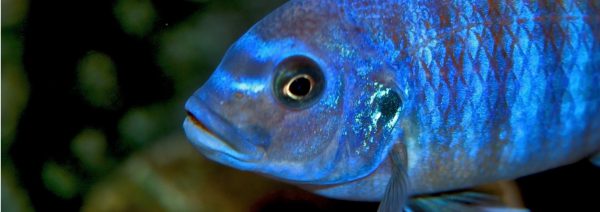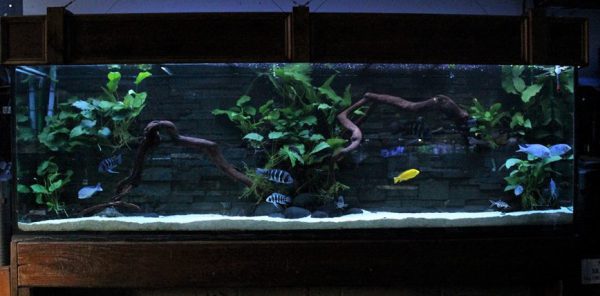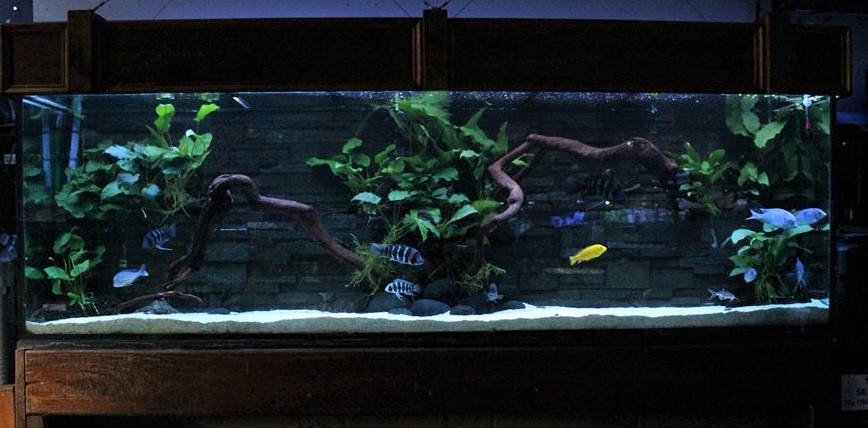African Cichlid Aquarium Setup Guide

African Cichlids are a family of fishes from various lakes in Africa. The three main lakes are Tanganyika, Malawi and Victoria. Although a majority of these fish enjoy similar water parameters and environments and make great tank mates, it is always suggested that you chat to us in regards to suitable tank mates for your specific Aquarium inhabitants. Generally speaking, some smaller Tanganyikan Cichlids like shell dwellers will duit smaller aquariums, where as larger peacocks and predators will require larger aquaria. Some of which can grow as large- if not larger than your hand or forearm. Many of these fishes have specialised diets and require plant matter and algae. Most African Cichlids have a very strong pull towards efforts to breed, this includes a naturally territorial nature. Balance is best found in large aquariums with hiding spots and high numbers of fish. Have a chat to us about your particular fishes needs, they are all uniquely different!
Ideal Water Conditions
It is always important to understand and be aware of your water parameters, particularly in a new aquarium while the aquarium cycles in the first few weeks. Be aware of how your aquarium is functioning and dealing with waste, to ensure your fish are living in a stable, healthy, and clean environment. We use and recommend API Test kits, the Freshwater master Kit is complete with all of your essential tests- a must have for any Fish Keeper!
Your set up guide will recommend that you see use in store weekly for the first month of your new aquarium to monitor your new aquarium as it establishes. A water test in store has a small fee.
Water Treatment
Water conditioners are essential for the health of your aquarium, gone are the days where the chemical in tap water would evaporate in sunlight over 48 hours, these days; unfortunately there are chemicals added that will not evaporate and chemical de-chlorination is necessary. Conditioning your water is essential for fish health, almost more importantly; for the safety of your beneficial bacteria. Always de-chlorinate your tap water. Sydney’s water is treated with chlorines, chloramine, ammonia, fluoride as well as a list of other chemicals which are harmful to your, fish and live bacteria. We carry a range of products which bind to these chemicals and render them harmless. Talk to our staff to choose which one is right for you and your aquarium.
pH
The pH value is the measure of hydrogen in relation to the level of hydroxyl concentration in water (too confusing?). Essentially, it is a measure of how acidic or alkaline the water is. The scale runs from 0-14 with 7.0 being neutral. The scale is logarithmic, with each step being ten times greater than the step before. Eg: a reading of 8.0 is ten times more alkaline then 7.0, and 9.0 is 100 times more alkaline than 7.0 and 6.0 is ten times more acidic than 7.0. pH plays an important role in how comfortable the fish is, and how they regulate their internal chemical reactions to support life. Generally speaking the spectrum between 7.4 and 7.9 is ideal for most Malawi and Victorian African Cichlids and all the way up to 8.3-9.3 for Tanganyikan African Cichlids.
Carbonate Hardness
Ideally the level of carbonate hardness in your aquarium should be kept at 120ppm. Carbonate Hardness is the level of Carbonate and Bicarbonate in the water. Carbon dioxide dissolved in water reacts with calcium and magnesium to form carbonates. Acids from waste breakdown and carbon dioxide will reduce carbonate hardness value in water, altering Ph.
General Hardness
Best described as ‘trace’ elements, Calcium, magnesium, potassium, sodium, sulphates and chlorides. These are essential for sustaining life in an ecosystem. These too are effected by acids in the breakdown of biological waste and when lowers, can alter the Ph. Another reason that shell grit, limestone or coral bones are helpful. The ideal reading for general hardness in your aquarium is between 160ppm and 200ppm.
Waste Levels
Because cycling an aquarium can initially be unstable and occasionally toxic, we recommend using live bio culture or products like Quick Start and Stress Zyme (or Stability), this allows improved good bacterial growth that will breaking down your fish waste.
Ammonia
Fish waste forms Ammonia, which very quickly becomes toxic at high levels. An ideal level is 0-0.25 ppm.
Nitrite
As Nitrite forming bacteria (Nitrosomas) develop, ammonia will be converted into Nitrite, while this is a relief that the ammonia levels will begin to decrease, the waste produced from these bacterium will produce Nitrite, which at high levels can also be toxic. An ideal level is 0 ppm.
Nitrate
As Nitrate-forming bacteria (Nitrobactors) develop, nitrite levels will decrease and nitrate levels will increase. When ammonia and nitrite levels are absent and nitrate levels are slowly rising, your aquarium is cycled and is home to billions of small bacteria that will help keep your aquarium clean and stable. Keep in mind, that over time Nitrate will build up (as in an aquariums environment, nitrate absorbing bacterium is near impossible to sustain) that nitrate too, at high levels, will become toxic. Partial water changes of 40-50% every fortnight will help dilute these levels. An ideal level is below 20ppm. Gravel siphoning is always recommended at least every second water change.
Phosphate
Present in all aquariums, phosphate can come from organic or inorganic forms, decaying fish, plants or waste, as well as introduced through chemical, foods, and buffers. Not only can phosphates stress your fish and lower their immune systems, but it can also cause algae blooms. Be sure not to use buffers or pH regulators that contain phosphates, and if feeding frozen foods, be sure to rinse thoroughly. Water changes dilute phosphate build up, a safe level is below 0.5 ppm.
Lighting
In the wild, the waterways these fish live in will have about 6-8 hours of unfiltered or high intensity lighting. Replicate this with your lighting on a timer, you can set it to hours when you will be home to view the aquarium, like afternoon to evening. Surplus of 8 hours may lead to excessive algae growth.
Heating
African Cichlids prefer a stable temperature of between 24-26C. Always use a thermometer to double check your temperatures and monitor possible fluctuations. Fish are ecto-thermic, and cannot produce their own body heat, its important to use an Aquarium Heater that is thermostat set to heat your aquarium, Large African Cichlids should have their glass heaters protected with a rubber heater guard.
Shopping List
– Aquarium
– Filter
– Gravel
– We recommend Natural Gravel or a Lime Sand or coral grit (to help raise pH)
– Water Conditioner
– Aquarium Salt (Cichlid Lake Salt)
– pH Buffer (Seachem Malawi/Victoria OR Tanganyikan Buffer))
– Plants/Driftwood/Ornaments/Rocks
– Air stone and pump (optional)
– Aquarium heater set to 24-26°C
– Thermometer

DAY ONE
– Place your Aquarium on your Cabinet, bench or other surface capable of holding the full weight of the aquarium (remember each Litre is 1 Kilo). En-sure that it is level, on even flooring, and centred (all four corners are evenly supported). Glass bottom aquariums should have a layer of foam support.
– Wash your gravel thoroughly in a bucket with a hose. It is often a good idea to separate the bag in portions of 1/5th at a time. Rinse until water runs clear and gravel is free of dust and debris. Gently place Gravel into Aquarium and spread evenly across the bottom. You’re aiming to have a gravel bed about 3-5cm deep.
– Wash your filter media (foam, noodles and/or cartridges) under the tap to clean it from dust. This is the ONLY time you will rinse any filter media under the tap, from this point forward it is only cleaned in old aquarium water, never under the tap. (For future reference, carbon cartridges should be replaced every 6-8 weeks and foam layer when required, if ceramic media needs to be replaced, replace no more than 1/3 at a time).
– Install your filter as the instructions direct, position the outlet so the surface of the water is disturbed and causing ripples, this helps to oxygenate the water.
– Fill your aquarium (slowly) with tap water, making sure not to disturb the gravel. Fill the Aquarium to a maximum level mark, or generally 1-2cm below the brim. At this point, you will add your De-chlorinator Water Conditioner, Buffers and Aquarium Salt as per directions.
– Plant your plants and place your driftwood and ornaments where desired.
– Turn on Lighting (to make sure they work).
– Turn on Heater and Pump, check that heater is keeping a stable water temperature of 24-26C. This may take a few hours from initial fill. Place your thermometer in a visible spot so you can monitor temperature fluctuations.
– Run the Aquarium for one whole week before adding fish, heater and filter stay ON 24/7. Lights run ON for 8 hours a day during day light hours (we recommend a timer). If you do not have live plants, feel free not to run the lights for the first week.
– Be patient.

DAY SEVEN
Shopping List
– BioCulture Live Bacteria
– Food
– Pellets
– Flakes – Frozen Foods
– Live Plants
– Your first Fish
– Pick out your first. Pay attention to our labels- We offer discounts on multiples for fish who require friends or prefer to school. As a general rule these are mini-mum recommendations. We recommend adding all of your fish slowly over a matter of weeks. For a small Aquarium, follow our advice and just add a small group, Increase the amount of waste your aquarium is producing in small intervals. Ask our advice, we’re here to help!
Cichlids do best when being added in groups of 3 or more, this limits aggression and focus on one particular fish.
– Float your new fish in your aquarium as per instructions on the bag.
– Your Bio-culture needs to be kept in the fridge when not being used, we suggest
dosing on Day 1, Day 3 and Day 6. At this point we suggest testing your water, as at this stage we may need our first water change, and possibly more doses of Bioculture. Come in for a Water Test after one week.
– Do not feed us the day we come home. Your new fish have already had breakfast at the store, and will probably be too overwhelmed to think about eating. We suggest feeding just every second day for the first week, and then daily thereafter. Remember our stomachs are only small and generally the size of our eye. Fish are opportunistic feeders and will over feed if you let them.
DAY FOURTEEN
Your new fish have been home with you for one week, your fish have been eating and making a mess. We’d like to see you and a 250ml sample of your aquarium water for a water test, to see how well your Aquarium is dealing with waste.
– Come in store for a Water Test.
– When you get home, do a 40% Water Change. Turn your filter and heater turned off, and keep your fish in the Aquarium for this. Use your Gravel Syphon to drain water into a bucket or drain. Lower and raise (vertically, do not stir) the siphon into your gravel. When you raise the siphon gravel will fall back down (gravity) and water and waste will continue to siphon. This first time, you may not see much waste draining out, although this is practice for future water changes. De-chlorinate your 40% empty aquarium with your water conditioner, add a dose to treat the entire aquariums capacity, then add a dose of salt for the water removed only, and begin filling with tap water.
– Remember to dose your buffer and salts for the percentage of water you removed.
– Wait 2 hours before dosing bio-culture after a recent water change.
ON GOING
30-50% Water changes should occur once a fortnight, or weekly for very small aquariums. We’d like to see you fortnightly with a water test at least until your aquarium has fully cycled. After this, your aquarium should be well established, and you should test yourself (or with us in store) at least once every month or two, or more frequently when issues occur. At any sign of illness or odd behavior, please feel free to phone us, or come in store with a water sample and photos of your setup so we can do our best at resolving the issue.
If you have ANY further questions, please feel free to call us on (02) 9905 1414 or visit us in store!




